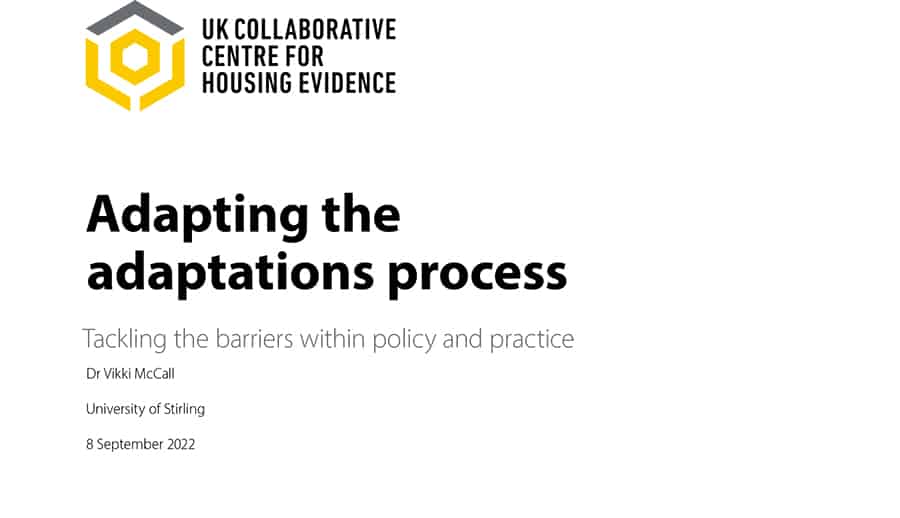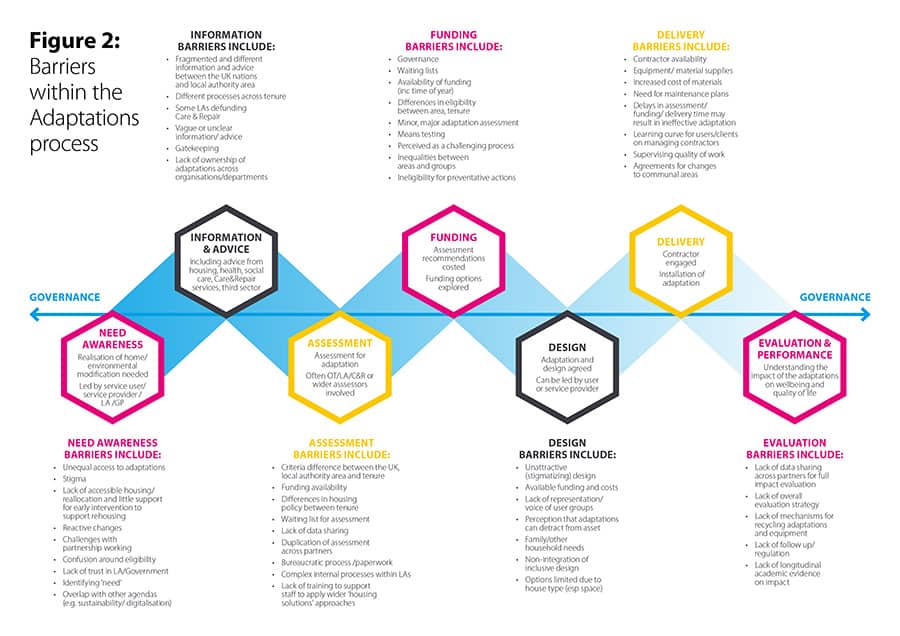“Fragmented” adaptations process in Scotland in need of an overhaul, report says

An interesting report has been published that takes an insightful and in-depth look at the “fragmented, overly complex, and bureaucratic” housing adaptations process in Scotland.
The publication identifies key barriers to important adaptations in Scotland and makes a series of recommendations to improve the overall process and experience that service users face.
Written by Dr Vikki McCall, Senior Lecturer in Social Policy and Housing and Deputy Associate Dean for Teaching and Learning in the Faculty of Social Sciences at the University of Stirling, the report, ‘Adapting the adaptations process: Tackling the barriers within policy and practice‘, was published on 8 September 2022.
The report begins by explaining the importance of housing adaptations to support the ageing population; futureproof homes; support health, social care, and wellbeing needs; and prevent health crises.
Home adaptations include the provision of assistive technologies in people’s homes, such as installing a homelift, grab rails in the bathroom, adding a ramp to front doors for step-free access, or lowering kitchen worktops so that they are accessible to wheelchair users.
However, the document warns that current adaptation processes in Scotland are disjointed, difficult to understand, and inconsistent across local authorities.
Following in-depth discussions with key stakeholders, there are clear barriers to home adaptations, according to the report.
One such barrier is governance and management surrounding adaptations support, which is perceived as “disjointed”. There is a lack of ownership that impacts all aspects of the adaptations process.
Currently, councils are responsible for adaptations assessment, planning, resourcing, and the duty to provide grants. However, the transition to local authorities having these responsibilities has been “patchy”, which has resulted in a fragmented policy landscape and a “postcode lottery” for adaptations provision in Scotland, the report underlines.
Another barrier is a difficulty in identifying adaptation “need” and an increasing overlap with other government agendas with unequal access to adaptation.
The report continues: “Stigma attached to adaptations can result in reluctance to access support, which is amplified by the overall lack of accessible housing. This results in adaptations often being reactive (rather than proactive) with additional challenges with partnership working between health, social care and housing.”
Fragmented information and advice are highlighted as another key barrier. The document says that advice on adaptations differs between UK nations and local authority tenure, making adaptations confusing for both service providers and the general public. Pathways to information and advice is also unclear, the document notes.
Assessment resource and capability is further identified as a barrier. The report underlines that criteria, eligibility, assessment processes and allocated staff resources differ within the UK, influenced by funding availability. The impact of this can be seen in lengthy waiting lists for assessment, which are made more challenging by bureaucratic procedures and complex partnership working.
Another adaptation barrier is funding. The report notes: “Diverse governance set ups, availability of funding (influenced by the time of year) alongside the differences in eligibility between area and tenure create a confusing funding landscape for adaptations. There are variances in how services handle and provide simple and complex adaptations.
“There is also means testing for the private sector, perceived as a challenging process and resulting in inequalities between areas and groups. This makes funding for preventative actions difficult to support.”

Unattractive and stigmatising designs are also a barrier, the report emphasises, which can lead to the perception that adaptations can detract from homes. Good designs are dependent on the funding available and costs. Service users are frequently not included in the adaptations process.
Additionally, delivery of adaptations is noted as another barrier. A lack of available contractors, materials, and equipment can lead to delays in assessment, funding and delivery time.
The final key adaptation barrier that the document points towards is the lack of evaluation and performance monitoring. Post-installation, the effectiveness of adaptations are not examined.
The report explains: “Future longitudinal academic evidence on impact is essential to help with ongoing efficiencies that give insight to ‘what works’ and this should also be evident in local performance monitoring arrangements so that this type of data is systematically gathered to evidence the outcomes and benefits from the provision.”
To address these barriers, the report makes a series of important recommendations to ensure that adaptations in Scotland are effective and unvaried across the country.
These include creating a simplified, tenure-neutral adaptations process; evaluating the full extent of adaptations investment as a system, including a review of the process for means-tested adaptations grants for the private sector to understand the entire funding landscaping; and creating adaptation support hubs that focus on supporting partnership working, training and sharing good practice at the local level.
Other suggestions made are creating consistent, integrated and sustainable local governance and partnership mechanisms between housing, health and social care that jointly agree strategy and policy, define integrated roles, and support the delivery of training which helps utilise the best use of resources; ensuring an inclusive approach to design, building and retrofitting adaptable and flexible housing that supports all groups; ensuring systematic evaluation of the outcomes from adaptations to evidence ‘what works’ and influence future strategy and resource allocation; increasing funding for adaptations to address the increase in cost in materials and works; and integrating adaptations into planned maintenance programmes and integrating recycling options to future proof housing.

